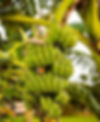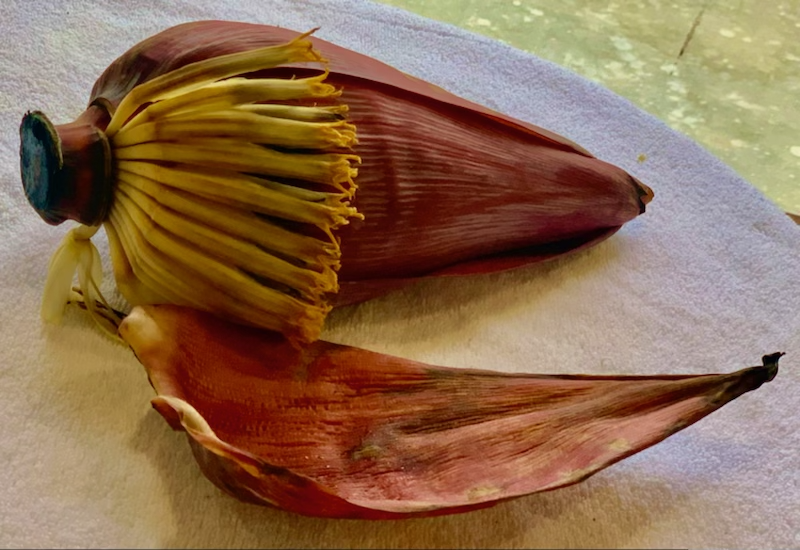The Majestic Banana: Nature's Eternal Gift of Generosity
- Geetanjali Chakraborty
- Sep 16, 2021
- 6 min read
Updated: May 4, 2024
As a granddaughter of India’s partition in 1947, I've had the unique privilege of being born into a bi-cultural family. My paternal grandparents migrated to India from East Bengal (now Bangladesh), while my maternal grandparents came from West Punjab (now Pakistan). Growing up, I fondly recall the rich blend of Punjabi and Bengali cuisines that filled our home. This fusion became second nature to me from a young age.
My Punjabi mother, intrigued by the flavors of East Bengal, eagerly learned the art of Bengali cooking from her mother-in-law, who lived with us. Thanks to her, I was immersed in the delights of East Bengal cuisine. Now, in my marriage to a Bengali, I find joy in reintroducing these flavors to him in a new context.
As I delved deeper into Ayurveda, I developed a profound appreciation for Bengali cuisine, which is deeply rooted in Ayurvedic principles. In this post, I'll explore the significance of one particular ingredient: the Majestic Banana, a staple in Bengali culinary tradition.
Geography and the Banana
West Bengal, also known as Poshchim Bongo, is a lush state where the mighty Ganga river concludes her journey by merging into the Bay of Bengal. It boasts both riverine and coastal landscapes, dotted with numerous ponds. This geographical diversity is significant in the context of Ayurveda, which categorizes lands into three types: anup (marshy), jaangala (dry/desert), and saadhaaran (a combination of the former two). This typology serves as a universal descriptor for any terrain. The banana thrives in anup desha (marshy land), and given Bengal's abundant water bodies, it predominantly exhibits marshy characteristics.[1]
Embark on a road trip through Poshchim Bongo, and you'll encounter vast expanses of banana groves stretching across the countryside, imprinting a distinct mark on the landscape. Bengalis are renowned for their culinary prowess and penchant for diverse food preparations. However, the region has also grappled with a history of famines and droughts. This juxtaposition of climatic challenges alongside a deep-rooted love for food has spurred a culinary ingenuity unique to this area. Every part of the banana plant—its fruit, flower, stem, and leaf—is utilized by Bengalis in various culinary creations.

Let’s take a look at every part of this wonderful plant and examine it within its cultural context.

The Fruit: Ripe Banana
The banana holds a special place in Indian literature, even capturing the imagination of the prolific Nobel laureate poet, Rabindranath Tagore, who immortalized it in one of his earliest childhood poems.
"Aamshotto dropped in milk, Mashed further with shondesh, The sounds of slurping, Surrounded by a stunned silence, Ants crying at the empty plate."
Known as Kadali in Sanskrit and Kodoli in Bengali (as evident in Tagore's verse), the banana has a rich cultural significance.
However, a note of caution: Despite Tagore's tempting description, mixing bananas with milk, as depicted, isn't recommended from an Ayurvedic standpoint. Few fruits can be safely combined with milk, and bananas aren't among them.
Let’s examine the banana’s properties from an Ayurvedic perspective.
तत्फलं मधुरं शीतं विश्तम्भी कफकृद्गुरु ।
स्निग्धं पित्तास्रतृङ्दाहक्षतक्षयसमीरजित् ॥३१॥
- Madanapala Nighantu
Shloka Translation: Banana fruit is sweet, cooling, aggravates kapha, and is heavy. It is oily, alleviates pitta and inflammation. It promotes healing of wounds and tissue regeneration. It aids in pacifying vata.
For optimal benefits, it's advisable to consume locally grown bananas. This ensures that the body receives nutrients suited to the local climate and weather conditions. Due to its heavy digestibility, ripe bananas are best enjoyed on their own, without mixing with other foods.
कदली वारणा वारणबुसाम्बुसारांशुमती फला ।
मोचाफलं स्वादु शीतं विष्टम्भि कफनुद्गुरु ॥३३॥
- Bhavprakash, Phalavarga 33
Shloka Translation: Banana is known by various names - Kadai, Varana, Ambusara, Amsumat. This fruit is considered sweet, cooling, kapha aggravating and heavy to digest.
स्निग्धं पित्तास्रतृड्दाहक्षतक्षयसमीरजित् ॥
पक्वं स्वादु हिमं पाके स्वादु वृष्यंच वृंहणम् ।
क्षुत्तृष्णानेत्रगदहृन्मेहघ्नं रुचिमांसकृत् ॥३४॥
- Bhavprakash, Phalavarga 34
Shloka Translation: Banana is unctuous, pacifies pitta, blood, and vata. When ripe, it is sweet in taste, cooling, sweet in post-digestive effect, increases virility, and promotes bulk. It is useful in hunger, thirst, eye diseases, urinary disorders, enhances taste, and promotes bulk.
The Vegetable: Raw Banana or Plantain

Raw banana, known as "kaacha kola" in Bengali and "kachcha kela" in Hindi, holds a cherished spot in Bengali cuisine as a cooked vegetable. Its astringent quality aids in digestion and can provide relief for upset stomachs, particularly during episodes of dysentery or loose bowel movements.
One of my favorite preparations involves simmering raw banana in a stew infused with stone-ground ginger and cumin paste. It serves as a nutritious alternative to potatoes, offering a soft texture when cooked and boasting a rich iron content.
In Northern India, raw bananas are also highly esteemed and feature prominently in special festival recipes.
The Banana Leaf
The banana leaf's expansive surface area renders it an optimal choice as a biodegradable serving plate for meals. Once the meal is concluded, the leaf can be easily folded and disposed of, allowing animals and microorganisms to naturally decompose and benefit from its remnants.[2]

Banana leaves play a significant role in Bengali cuisine, particularly in a cooking style known as "Paaturi," derived from the Bengali word "Paata," meaning 'leaf.'[3] In this method, fish or vegetables are wrapped in banana leaves along with mustard paste and spices, then steamed to perfection. For non-vegetarian Bengali households, this dish pairs wonderfully with rice.
For vegetarian alternatives, Bengalis substitute fish with paneer, mochaa (banana flower), or other seasonal vegetables prepared in a similar manner.
The banana leaf's natural moisture facilitates the steaming process, infusing the ingredients with nutrients as they cook. This enhances the food's flavor and imparts a tantalizing aroma, characteristic of Bengali cuisine.
The Flower: Mochaa
The banana flower, known as "Mochaa" in Bengali, is a key ingredient in a dish called "Mochaar Ghonto." In this preparation, the banana flower is finely chopped and sautéed with a blend of aromatic spices.
RECIPE FOR BANANA FLOWER: MOCHAAR GHONTO |
Step 1: If the banana flower is from an unripe banana plant, soak it overnight in a mixture of salt, turmeric, and lemon juice. Step 2: The following day, rinse the flower thoroughly and boil it with a pinch of salt and turmeric to remove its astringent quality and enhance its flavor. Step 3: After removing the stem from within, finely chop the banana flower (mochaa). It's crucial to discard the stem as it remains tough even after cooking. Step 4: Optionally, dice some potatoes and season them with salt and turmeric. Sauté them separately for a few minutes. Potatoes are often added to Bengali dishes to increase their volume, historically serving as an innovative solution during times of food scarcity. Step 5: For an extra layer of flavor, fry sliced coconut until golden brown and set it aside. Step 6: Heat a few tablespoons of oil in a pan. In West Bengal, where the climate tends to aggravate kapha and vata, mustard oil is traditionally used due to its natural heating properties. However, depending on the climate, alternatives like sunflower oil or ghee can be used. In the Bay Area, where the weather is a combination of marshy and dry, sunflower oil is preferred in summer, while ghee is favored in winter. Step 7: Once the oil is hot, add a bay leaf, 2-3 cardamom pods, an inch of cinnamon stick, grated ginger, cumin powder, and chopped tomatoes. Sauté until the oil separates, then add the chopped and boiled banana flower, along with the sautéed potatoes and fried coconut. Cook over medium heat until the vegetables are tender. |
The Banana flower can originate from two distinct varieties of the banana plant, each requiring a different preparation method. If it comes from a plant bearing ripe bananas, it can be cooked directly as it offers a sweet taste. However, if sourced from an unripe green banana plant, it tends to be bitter due to its astringent nature. In this case, marinating the flower in lime and salt overnight is necessary before cooking it the next day.
A simple visual examination aids in distinguishing between the two types: a ripe banana flower typically exhibits a conical shape, while an unripe one tends to be cylindrical.
RECIPE FOR BANANA FLOWER WRAPPED IN LEAF: MOCHAAR PATURI |

Note: This is a considered a dish for special occasions and is quite popular in Bengali restaurants. It is especially consumed during monsoon when kapha increases in the atmosphere so the heating spices in this dish help balance it out in the body. |
Banana Flower Pod

To prepare the inner core of the Banana Flower (Mochaa), also known as the flower pod, it's essential to clean it thoroughly by removing the dark stem. This step ensures that the core becomes tender and easily digestible after cooking. Once cleaned, the core is utilized to create a flavorful fried dish known as Bhutuk. Bhutuk is commonly served as a delicious accompaniment alongside lentils and rice.
RECIPE FOR BANANA FLOWER POD: BHUTUK |
 Step 1: Cut the cleaned inner core into long slices and steam it.
Step 2: Immerse it in a batter of rice flour with Kaalo Jeeray (Nigella Seeds) and salt.
Step 3: Deep fry into a fritter and enjoy it with rice and lentils.
|
The Stem: Thore
The inner stem of a Banana tree, known as Thore, is abundant in water and nutrients. However, it is encased in an outer fibrous layer that must be peeled away to reveal its soft, white core.
I recall being taught by my grandmother the meticulous technique of curling the fibers around my index finger to remove them. While this process may be painstaking, it's crucial to ensure that the fiber hairs are eliminated, as they can otherwise become lodged in the mouth while eating, detracting from the dish's flavor. This tradition persists not only in Bengal but also in the Southern states of India. Once the fibrous layers are discarded, what remains is a tender white core, finely chopped and sautéed with spices to create a delectable side dish.
RECIPE FOR BANANA STEM: RICED THORE |
 Step 1: Soak the chopped banana stem (thore) in cold salt water for at least an hour. This prevents the vegetable from darkening due to exposure to direct oxygen and helps in mashing it later. Step 2: Drain the salt water after an hour and wash the soaked vegetables for a few minutes. This softens the vegetable. Step 3: In a pan, add a little ghee (clarified butter), half a teaspoon of black mustard seeds and 1 whole red chili. Add the mashed-up banana stem (thore) to this mix and sprinkle turmeric and salt to taste. Sauté the mix until fully cooked. |
Now let’s look at what Ayurveda has to say about the Banana stem:
कदली योनिदोषाश्मरक्तपित्तहरा हिमा ।
तत्कण्डः शीतलो बल्यः केश्यः पित्तकफास्रजित् ॥३०॥
- Madanapala Nighantu
Shloka Translation: Banana is beneficial for conditions concerning the reproductive organs, urinary stones, and bleeding disorders. The stem of the banana plant possesses cooling properties, strengthens the body, and promotes hair health. It helps pacify both pitta and kapha doshas.
Old Plant, New Respect
With a newfound admiration for the banana, I've gained a deeper respect for this generous fruit, the Majestic Banana! I take pleasure in observing its growth on my parents' rustic farm and relishing the lovingly prepared dishes by my family.
Whether you have the privilege of nurturing your own banana plant or simply encounter one in your surroundings, consider greeting it with a sense of reverence. For those residing in the San Francisco Bay Area, rest assured that you can find various varieties of banana plants here. During your next visit to an Indian store, keep an eye out for other parts of the banana plant, such as mochaa and thore. And when you're looking for a fun activity with friends, why not go bananas!
1. Note that Florida is another example of anup desha where bananas grow well.
2. In the Western world, one has to be careful to find a banana leaf from a plant that is organic in order to avoid harmful chemicals that may be sprayed on them. In West Bengal, usually the leaves are chosen from a plant in one’s own backyard since banana grows widely in most households’ kitchen garden.
3. I have eaten something similar in the Bay Area but with a corn leaf, and it is called Tamales.











